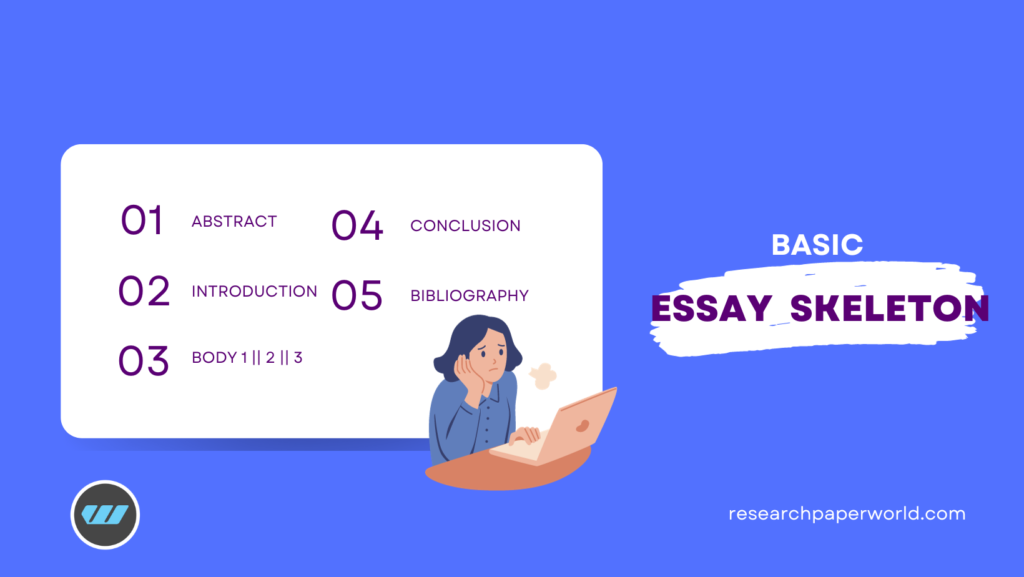I know what you’re wondering, what is the difference between an essay skeleton and an essay outline? To be honest, there is very little difference other than the outline tends to come equipped with a little more meat. The essay skeleton is, as the name suggests, just a basic frame of reference that helps students organize their ideas and define what goes where. In most cases, it does not have too much content other than the titles and subtitles and maybe topic sentences.
A thesis statement is also a welcome edition to the skeleton. In comparison, an outline will usually have brief paragraphs that define what the segment will talk about. The skeleton is usually very heavily edited throughout the writing process.
So, why even bother creating an essay skeleton, you wonder? Simple, because it will serve as a boilerplate for all your written assignments. And I do mean all of them. Forever!
Let’s dive in and see how is this even possible.
Table of Contents
What is an Essay Skeleton
The skeleton is the framework that guides your writing. Think of it this way. If you wanted to build a house, the first thing you’d do is to draw a design, layout of the rooms, placement of the electric and water appliances, doors and windows, and similar. The skeleton is just like that, only for writing. If you do it properly, it will help you organize your research and writing, which saves time and lowers stress. So let’s dig in and see what can you do to make an awesome essay skeleton.

Understanding the Structure
Understanding the essay’s structure is crucial. Learn the anatomy of an essay: introduction, body, and conclusion. This comprehension guides your essay’s direction. In almost every situation you will come across, written work will have only three main parts – the introduction, the body, and the conclusion.
While in most cases there are some elements that must be added later such as the abstract or the bibliography, the three core elements never change.
Essay Skeleton Examples
Depending on the length of your paper, each part will vary in size and can encompass several sub-sections. It is important that you outline these immediately, as it helps define what you need to focus on. For example, a standard essay structure may look like this:
- Abstract
- Introduction
- Main body
- Body topic 1
- Body topic 2
- Body topic 3
- Conclusion
- Bibliography
If you need to write a longer paper, say 10-15 pages that requires primary or secondary research, then you would use something like this:
- Abstract
- Introduction
- Background
- Research question
- Thesis statement
- Literature review
- Main body
- Body topic 1
- Body topic 2
- Body topic 3
- Body topic 4
- Body topic 5
- Methodology
- Approach
- Method
- Material
- Procedure
- Sample
- Results
- Discussion
- Conclusion
- Bibliography
Selecting the Main Points
Choose the main points wisely. They form the backbone of your essay skeleton. Prioritize key arguments that align with your thesis statement. Don’t go into too much detail, but rather focus on those elements that make the core of your essay. If you’re writing about World War II, pick 3-5 main points and create body paragraphs first, and only then develop the other parts. This way you will be more prepared and know what to write about.

Crafting a Strong Thesis
Crafting a robust thesis statement is pivotal. It succinctly summarizes the purpose of your essay and sets the roadmap for your skeleton.
Building the Body
The body of your essay skeleton fleshes out your main points. Arrange them logically, ensuring coherence and progression.
Incorporating Evidence
Support your main points with credible evidence. This can include statistics, quotes, or scholarly references. Strengthen your essay’s structure with substantial support.
Conclusion and Recap
Conclude your essay skeleton with a concise recap. Reinforce your thesis and summarize the key arguments. A well-constructed skeleton ensures a robust essay.



